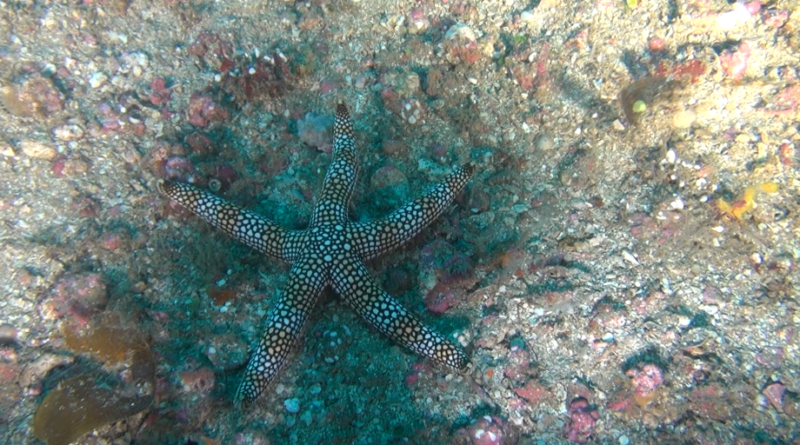Uncommon Habitat Found in Distinctive Kelp Beds of iSimangaliso Marine Protected Area
Johannesburg – iSimangaliso Wetland Park, celebrated for its remarkable biodiversity and eco-tourism offerings, has recently astounded the scientific community with a remarkable kelp discovery, highlighting South Africa’s concealed marine wonders.
During an exploratory survey on the WILDTRUST research vessel, the Angra Pequena, researchers uncovered South Africa’s hidden underwater forests, crucial for the ecosystem, located within the Park’s mesophotic zone; the part of the ocean where sunlight barely reaches.
In the latest research expedition aimed at studying the kelp forest characteristics, a team identified vast fields of rhodoliths – free-living, calcareous red algae that appear as pink-hued nodules scattered on the seafloor.
These seemingly ordinary formations play a significant role in marine ecosystems. Rhodolith beds are globally acknowledged as biodiversity hotspots, akin to coral reefs and seagrass meadows.
They offer refuge and nursery habitats for numerous marine species, ranging from invertebrates to juvenile fish.
Their intricate, three-dimensional structures stabilize sediments, enhance habitat diversity, and serve as essential substrates for kelp and other macroalgae.
Although the presence of rhodoliths in the larger iSimangaliso area was previously suspected, their extent and intricate relationship with the kelp bed represent a groundbreaking discovery.
The research team was spearheaded by Dr. Welly Qwabe and Professor Lucy Woodall from Ezemvelo KZN Wildlife and the University of Exeter (UK), alongside Dr. Vivienne Coetzee, a postdoctoral fellow at the University of Cape Town, working under the WILDOCEANS programme.
This remarkable discovery was made possible by support and funding from the National Research Foundation (NRF), Blue Action Fund, the National Department of Forestry, Fisheries and the Environment, Nekton, the South African Environmental Observation Network (SAEON), and Oceans 5, along with various local and global partners and collaborators.
A Rare Ecological Gem
This is only the second rhodolith bed ever documented in South African waters, the first being discovered off the Kei River in the Eastern Cape.
This finding is an unprecedented ecological milestone for KwaZulu-Natal and particularly for the exceptional iSimangaliso Wetland Park, a World Heritage Site.
The rhodolith beds were discovered alongside a dense forest of Ecklonia radiata (golden kelp), extending 35 kilometers along the seafloor.
“Together, these ecosystems form a complex partnership,” noted Coetzee, a postdoc who will conduct further studies on these newly discovered extensive rhodolith areas.
“Rhodoliths provide hard surfaces essential for kelp attachment, while kelp forests create canopy habitats that influence light, nutrient levels, and water movement.
“Their interconnected roles support carbon sequestration and provide crucial nursery grounds for commercially important fish species, essential for biodiversity conservation and sustainable fisheries.”
A Call for Conservation
“Rhodolith beds are delicate and slow-growing, often taking centuries to recover from disturbances. Threats such as bottom trawling, pollution, and ocean acidification put these vital habitats at risk,” stated Woodall.
“The discovery within iSimangaliso Wetland Park underscores the urgent necessity to protect not just the visible ecosystems, but also the concealed seascapes beneath the ocean’s surface.”
Dr. Jean Harris, WILDTRUST Strategic Ocean Lead and Captain of the Angra Pequena, remarked: “This discovery serves as a reminder of how much is still waiting to be uncovered beneath the waves.
“South Africa’s mesophotic habitats are vital biodiversity reservoirs, playing a key role in climate resilience and future blue economy opportunities.”
Riaan Cedras, Ecologist at iSimangaliso Wetland Park Authority, commented: “iSimangaliso MPA comprises unique and diverse marine ecosystems characteristic of the east coast of South Africa.
“The findings of this study are gradually revealing the secrets of the deep.
“Coral reefs. Kelp beds. The plankton and fish that sustain us.
“Research on species and ecosystems by partners in this World Heritage Site reinforces the need for continued research in this area.”
As WILDTRUST and research partners persist in uncovering and mapping these twilight treasures, the urgency for enhanced marine protections intensifies.
Protecting these ecosystems will ensure they continue to provide invaluable services for generations to come.

